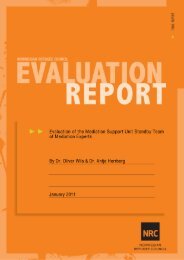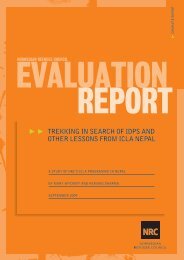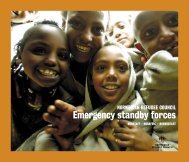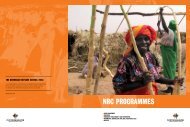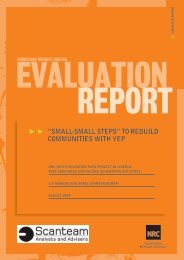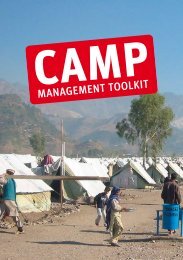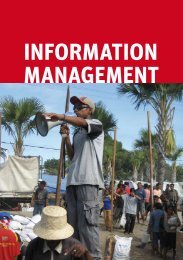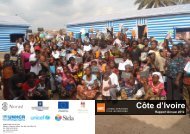evaluation of general food distribution in northern uganda: gulu ...
evaluation of general food distribution in northern uganda: gulu ...
evaluation of general food distribution in northern uganda: gulu ...
You also want an ePaper? Increase the reach of your titles
YUMPU automatically turns print PDFs into web optimized ePapers that Google loves.
7.2.3 Stimulat<strong>in</strong>g Other OptionsLike the statement made above the 2005 and 2007 EFSAs note that there is a strongrelationship between household <strong>food</strong> security and contribution <strong>of</strong> own production to the <strong>food</strong>basket. However, apart from blanket <strong>distribution</strong>s 113 <strong>of</strong> seeds and tools to a number <strong>of</strong> IDPs itseems that little has been done by GoU, humanitarian agencies or donors to 114 1) stimulateown production 2) facilitate the market 3) create employment opportunities 4) create<strong>in</strong>vestment prospects 5) help farmers save their produce or seeds 6) open up for <strong>in</strong>comegenerat<strong>in</strong>g activities and 7) revive animal husbandry … all <strong>of</strong> which are fundamentallynecessary for the IDPs to cover their net <strong>food</strong> gap (regular and seasonal) 115 .It is clear to humanitarian and recovery actors on the Ugandan scene that between relief andrecovery/development there is a gap without adequate <strong>in</strong>terventions and actors. While someshut down and phase out their operations others are supposed to open up, <strong>in</strong>crease andexpand. But <strong>in</strong>terventions <strong>in</strong> the area <strong>of</strong> <strong>food</strong> security, livelihoods, durable solution s, socialprotection and safety nets are still slow <strong>in</strong> tak<strong>in</strong>g <strong>of</strong>f. Some <strong>of</strong> the reasons given are lack <strong>of</strong>donor fund<strong>in</strong>g, lack <strong>of</strong> leadership from GoU to steer the process and lack <strong>of</strong> a consolidatedand coord<strong>in</strong>ated approach from recovery/development actors. C hapter 9 will discuss some <strong>of</strong>these challenges and dilemmas.7.2.4 Lesson Learned♦ IDPs have <strong>in</strong> <strong>general</strong> not been able to meet their net <strong>food</strong> gap as quickly as assumedfrom the beg<strong>in</strong>n<strong>in</strong>g <strong>of</strong> the project period. Meet<strong>in</strong>g the net <strong>food</strong> gap as well as nutritionalstandards is challeng<strong>in</strong>g if <strong>food</strong> ration reductions do not go hand <strong>in</strong> hand with livelihoodand <strong>food</strong> security expansion, particularly for more vulnerable groups and <strong>in</strong> the transitsites, where basic services are lack<strong>in</strong>g and markets for purchase/sale are far.♦♦With the ration reductions and no immediate livelihood opportunities, IDPs are forced <strong>in</strong>tovarious cop<strong>in</strong>g strategies, some more encourag<strong>in</strong>g than others. In worst cases the cop<strong>in</strong>gstrategies are <strong>of</strong> a degrad<strong>in</strong>g nature, challeng<strong>in</strong>g the protection <strong>of</strong> some <strong>of</strong> the IDPs.EFSA’s and nutritional surveys are faced by a series <strong>of</strong> methodological limitations, delaysand lack <strong>of</strong> nuances, which question their credibility. Yet these surveys comprise the solebasis for crucial decision-mak<strong>in</strong>g on <strong>food</strong> aid policy <strong>in</strong> Northern Uganda. Enhancedcorroboration, triangulation <strong>of</strong> data, comprehensiveness and <strong>in</strong>dependence <strong>of</strong> thesurveys will <strong>in</strong>crease the credibility <strong>of</strong> the evidence base for decision -mak<strong>in</strong>g.7.2.5 Recommendations♦ To address the reported problems regard<strong>in</strong>g the EFSAs’ methodology and credibility andprovide a more confident basis for decision mak<strong>in</strong>g and policy development at this time <strong>in</strong>Northern Uganda, an EFSA cum nutrition survey, <strong>in</strong>dependent, and <strong>of</strong> a higher qualityshould be conducted to establish a more comprehensive and varied assessment <strong>of</strong> <strong>food</strong>security, cop<strong>in</strong>g strategies, ability to meet the net <strong>food</strong> gap etc. The research should beconducted by <strong>food</strong> aid experts, some <strong>of</strong> whom may be drawn from current experienced<strong>food</strong> actors on the ground. An <strong>in</strong>dependent EFSA need not necessarily replace currentlyplanned EFSAs, but be additional to it. (This is also recommended <strong>in</strong> Chapter 11 on FoodPhase Out strategy). NRC should advocate for and contribute to the realisation <strong>of</strong> this.♦NRC should <strong>in</strong>vest <strong>in</strong> more specific research <strong>of</strong> various alternatives to <strong>food</strong> aid dur<strong>in</strong>gand after emergency sett<strong>in</strong>gs, with a view to strengthen peoples’ cop<strong>in</strong>g strategies asquickly as possible (ref. recommendations <strong>in</strong> Sections 5.4 and 7.1).113 Amongst others undertaken by GoU, ICRC and selected other NGOs114 Key <strong>in</strong>formant <strong>in</strong>terviews with District <strong>of</strong>ficials <strong>in</strong> Gulu, Kitgum and Amuru, WFP Gulu and Kitgum, OCHA Gulu and Kitgum,NRC, AVSI as well as selected <strong>food</strong> aid donors, Kampala.115All <strong>of</strong> which is also mentioned <strong>in</strong> the EFSA’s36





